The best crema pasticcera recipe! Make a smooth, creamy Italian pastry cream, perfect for filling tarts, cakes, pastries, and other delicious desserts.
Crema pasticcera, also called Italian pastry cream, crème pâtissière, or Italian custard, is a rich, silky cream used in all kinds of classic Italian desserts.
It’s the perfect cream filling for cakes, tarts, pastries, and more—and it’s so good, you might just want to eat it by the spoonful!
Made with just 5 ingredients, this authentic crema pasticcera recipe is super easy and you can whip up a big batch in just about 15 minutes.
Serve it into cups and top with fruit for a dessert on its own, or use it as a filling for a fruit tart, pie or cake, croissants ( cornetti alla crema in Italian), choux pastry puffs, or eclairs.
You can even replace British custard cream with Italian pastry cream in classic recipes such as trifle or bread pudding.
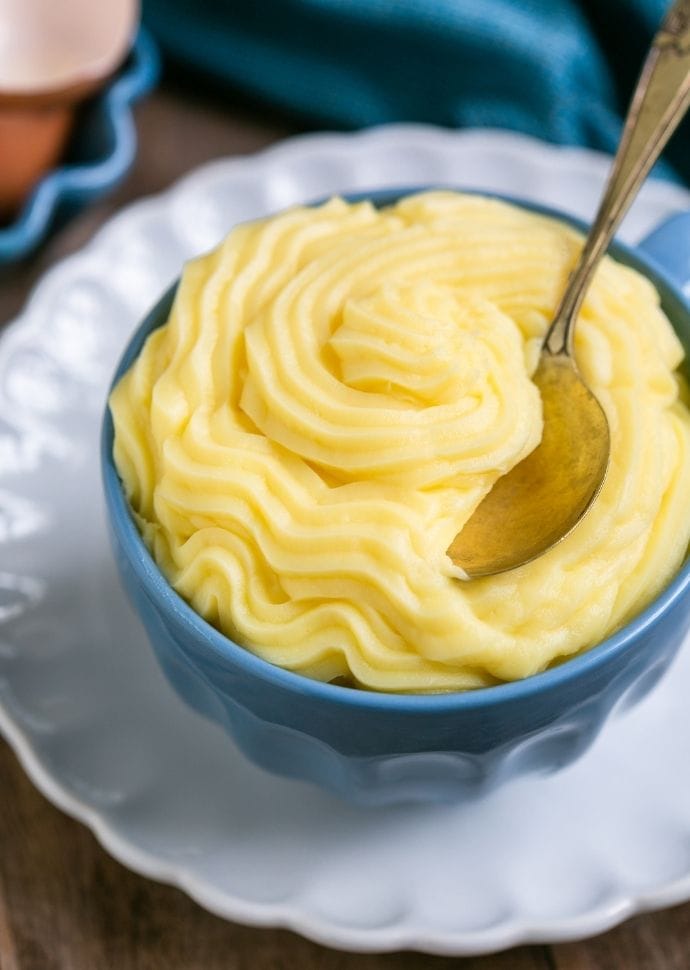
Jump to:
Difference between pastry cream and custard
Italian vanilla pastry cream and custard cream are very similar and use almost exactly the same ingredients.
The main difference between the two is the amount of each ingredient and the fact that custard includes heavy cream in addition to milk.
Custard is a lot thinner, more like a sauce and contains less cornstarch or flour, pastry cream is much thicker and will hold its shape.
Ingredients
In true Italian style, you only need just five simple ingredients to make crema pasticcera!
Here are my recommended ingredients for the best results:
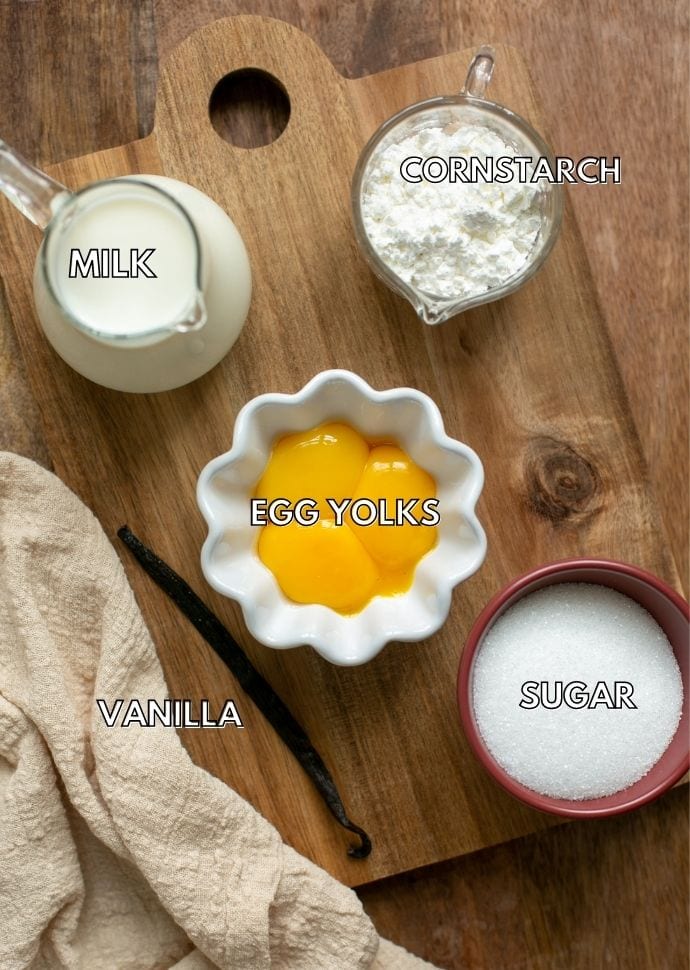
- Milk: You need fresh full fat milk for the best texture, avoid part-skim or skimmed milk.
- Cornstarch: This is also called corn flour or maize starch is what makes the cream thick and with a jelly-like texture when cold.
- Egg yolks: I use medium sized free-range eggs.
- Sugar: You can use both caster or raw cane sugar for this recipe.
- Vanilla: I prefer using vanilla bean for the best results. Cut the vanilla bean in half lengthwise and scrape out the seeds to use in the recipe.
SUBSTITUTIONS
- Milk: For a dairy-free pastry cream you can replace cow's milk with vegetable milk (rice, oat, soy, almonds).
- Cornstarch: You can substitute it with flour, but you’ll need to cook the cream a little longer. Check my tips section below for more info.
- Vanilla: You can substitute the vanilla bean with pure vanilla extract. I do not recommend vanilla paste as it often includes additives and extra sugar.
Italian pastry cream variations
Once you’ve mastered the basic Italian custard recipe, you can easily switch up the flavors to make it even more delicious!
- Coffee pastry cream: Add two teaspoons of instant coffee into the milk (step 3 of the recipe).
- Chocolate pastry cream: Add 100 g (3.5 oz) of melted dark chocolate, right after you whisk the cream (step 5 of the recipe) and mix until combined.
- Lemon pastry cream: Add the rind of an organic lemon (try to avoid the white bitter underneath layer as much as possible) whilst you heat the milk (step 3 of the recipe), then discard it.
- Diplomat cream: Mix in 200 ml (6.7 oz) freshly whipped cream after your pastry cream is ready (step 5 of the recipe). Diplomat cream is lighter, with a smoother and less jelly-like texture.
How to make creama pasticcera
This traditional crema pasticcera recipe takes about 15 minutes to make.
The fool-proof technique I’ll show you below is a bit unconventional from others you might have seen before, but trust me it works!
Scroll down until the end of the post for the full printable recipe.
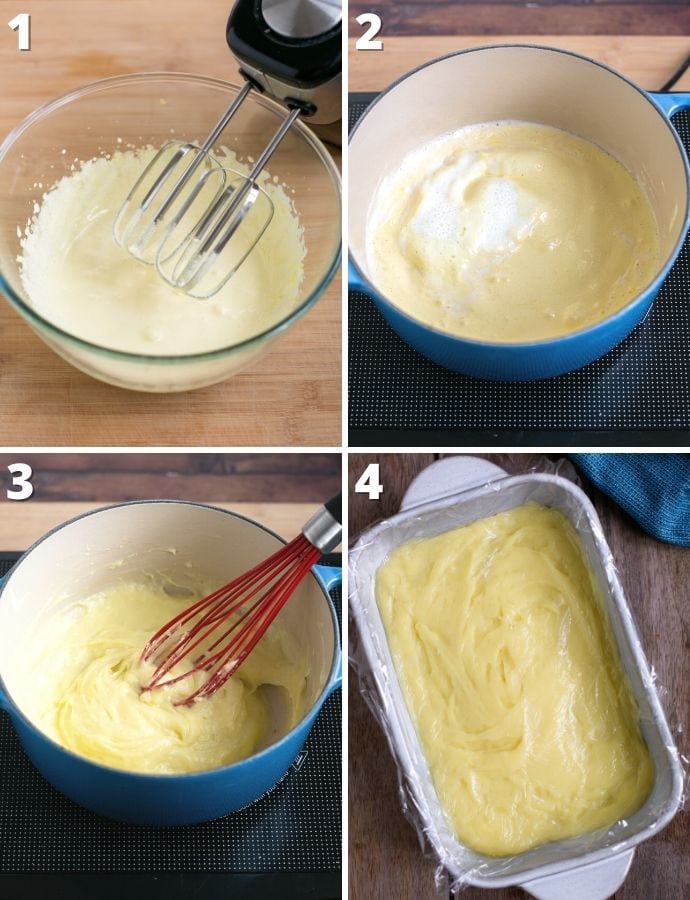
STEP 1. Whisk egg yolks, sugar, and vanilla for 2 minutes until light and fluffy. Gradually whisk in sifted cornflour until smooth.
STEP 2. Heat milk over low heat until it just starts to bubble, then remove from heat. Gently pour the egg mixture over the hot milk without stirring.
STEP 3. Let it sit for about 30 seconds until the milk starts to break through the surface. Once most of the egg mixture is covered, turn off the heat and whisk for 30 seconds until thick and creamy.
STEP 4. Transfer to a glass or ceramic dish, cover with plastic wrap touching the surface to prevent a crust from forming. Let it cool—it will thicken and hold its shape.
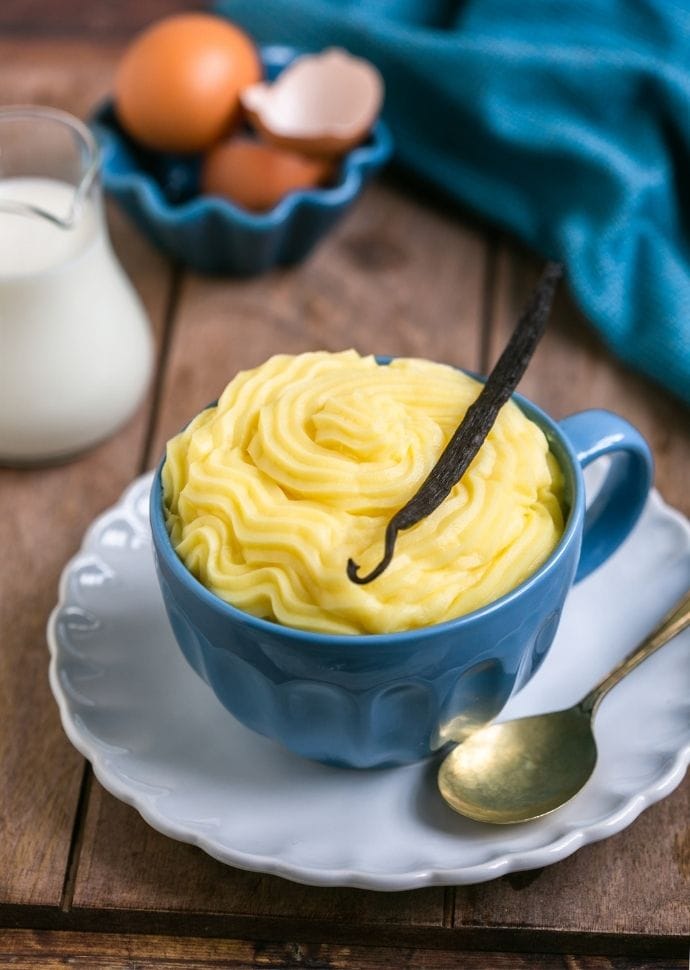
Tips for the best pastry cream
- If using flour instead of cornflour, cook the cream for a few minutes over 85°C, stirring constantly to prevent lumps or overcooking. Cornflour makes the process faster, easier, and naturally gluten-free.
- Remove from heat right before whisking (step 3 of the recipe) to avoid overcooking, which can make the cream grainy or lumpy.
- If the mixture seems too thin, take it off the heat, whisk quickly, then return to low heat for a few seconds if needed.
- Cooling in a baking dish instead of a bowl helps it set faster.
- Cover with plastic wrap touching the surface to prevent a crust from forming.
How to use Italian pastry cream
You can eat it with a spoon or use it as a filling for so many dessert recipes. Here are a few favourite ways to use it:
- Fill choux pastry puffs, croissants, muffins, cannoli, puff pastry squares or eclairs.
- Use as a filling for a fruit tart, crostata or chocolate cake (or any cake), pandoro, panettone or crepes and pancakes.
- Layer it in the classic mille-feuilles for a rich, creamy dessert.
- Swap it for custard in British trifle, Danish pastries or bread pudding.
- Make simple cookies with a classic Italian sweet shortcrust pastry dough and fill them with the cream.
How to use leftover egg whites
For this vanilla pastry cream recipe you will need to use only the egg yolks.
Use the leftover egg whites to make this delicious gluten-free chocolate cake or classic amaretti, Italian orange cookies, brutti ma buoni cookies or walnut cookies.
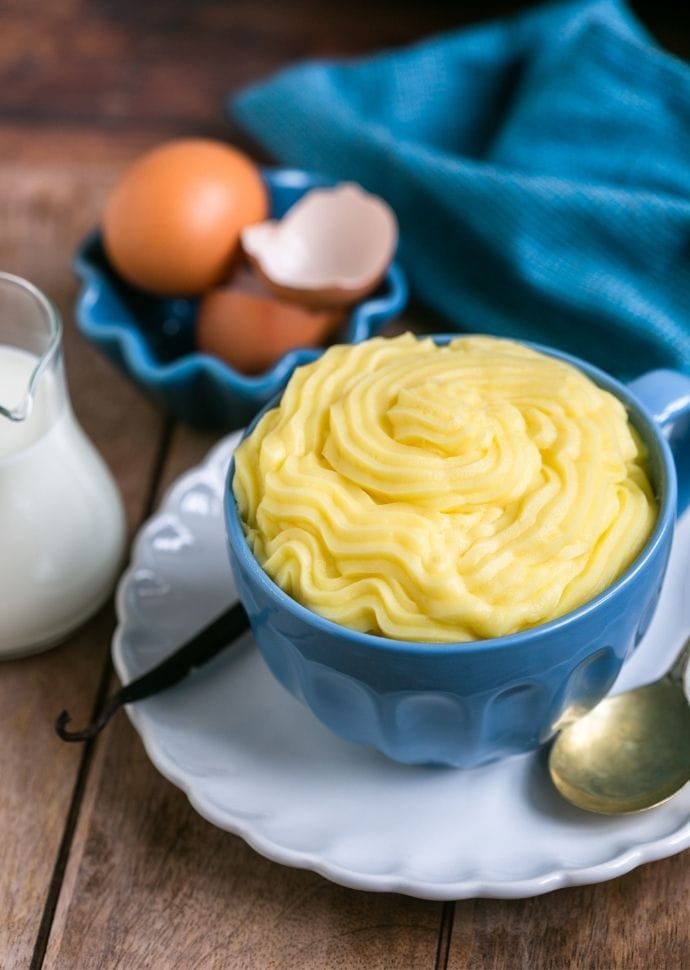
Storage tips
- Fridge: You can keep crema pasticcera in the fridge for up to 5 days. Cover it with plastic wrap pressed directly on the surface to prevent a skin from forming. Before using, whisk it gently to make it smooth again.
- Freezer: I don’t recommend freezing it because it can turn watery and grainy when thawed. But if you really need to, store it in an airtight container and freeze for up to 1 month. Let it thaw in the fridge for a few hours, then whisk well before using.
Recipe FAQs
Crema pasticcera should hold its shape once cooled. If it’s too thin, it’s likely undercooked or doesn’t have enough cornflour.
To fix it, mix 1 teaspoon of cornflour into the warm cream and blend quickly with a hand mixer. If needed, heat it gently for a few seconds while stirring until it thickens.
Lumpy pastry cream usually happens for two reasons: overheating or overcooking. If the eggs get too hot, they can curdle, causing lumps to form.
Don’t worry! If this happens, remove it from the heat and let it cool slightly. Then, strain it through a sieve to remove any lumps or blend it quickly with an immersion blender.
However, if the cream has a strong eggy taste, it's best to start over for the best flavor.
Did you try this recipe?
Please let me know how you liked it! Leave a comment below and share a picture on Instagram with the hashtag #thepetitecook!
Don't forget to subscribe to my newsletter and follow along on Facebook, Pinterest and Instagram for the latest updates.
Recipe
Crema Pasticcera - Italian Pastry Cream
Ingredients
- 6 medium egg yolks
- 160 g sugar
- 1 vanilla bean, or 1 tablespoon pure vanilla extract
- 30 g cornflour
- 500 ml fresh whole milk
Instructions
- Whisk the egg yolks with sugar and vanilla for about 2 minutes, until you get a light, fluffy mixture.
- Slowly incorporate sifted cornflour into the egg mixture, and whisk until it’s fluffy, smooth and well combined, about 2 minutes.
- Heat the milk over low heat until you see the first bubbles, then remove the pan immediately from the heat.
- Drop the egg mixture gently over the hot milk and return the pan over low heat. Do not stir.
- Wait a few seconds, the egg mixture will float over the milk surface (because the whipped mixture has incorporated enough air to remain on the surface).
- In about 30 seconds milk bubbles will pierce the surface of the egg mixture and it will slowly incorporate it.
- When most of the surface is covered with milk, turn the heat off, take the pan away from the heat, and immediately whisk the mixture vigorously for about 30 seconds.
- While you whisk, the mixture will almost immediately turn into pastry cream. It should be thick, creamy and smooth.
- Transfer your crema pasticcera into a ceramic or glass casserole dish or a baking pan, and cover with plastic wrap, making sure it touches the surface of the cream.
- Once cooled down, the crema pasticcera has a thick smooth texture and holds its shape, and it’s ready to be served or used in other dessert recipes.
Notes
- If you use flour instead of cornflour, you need to cook the cream for a few minutes, bringing it over 85° C, stirring constantly to prevent it from sticking.
- Remember to remove the egg and milk mixture immediately from the heat right before you whisk the cream, to avoid overcooking the mixture.
- If the mixture still appears unstructured, move away from the heat anyway, whisk quickly and place it again on the stove for a few seconds on very low heat.
- Using a baking dish to cool down the cream will make it set faster than in a bowl.
- Cover the prepared pastry cream with plastic wrap making sure it adheres perfectly to the surface of the cream, to prevent a thin crust from forming over the surface.
Nutrition
The information shown is an estimate provided by an online nutrition calculator. It should not be considered a substitute for a professional nutritionist’s advice.



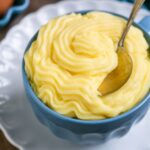
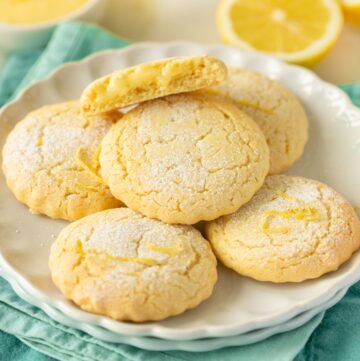
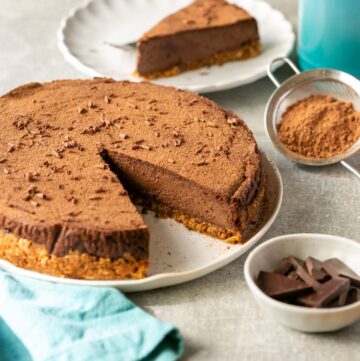
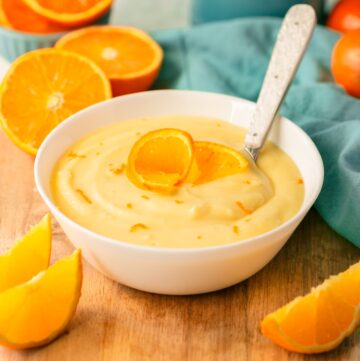
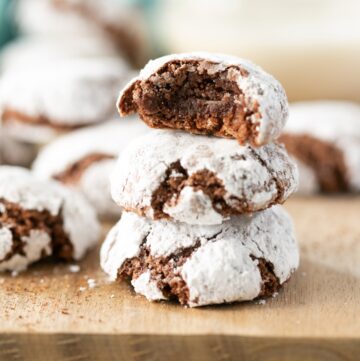
Victoria says
Steps 2 and 3 are in conflict:
STEP 2. Heat milk over low heat until it just starts to bubble, then remove from heat. Gently pour the egg mixture over the hot milk without stirring.
STEP 3. Let it sit for about 30 seconds until the milk starts to break through the surface. Once most of the egg mixture is covered, turn off the heat and whisk for 30 seconds until thick and creamy.
When does the heat need to be turned off?
Andrea says
Hi Victoria, the heat is turned off at the end of step 3, you briefly remove the pan from the heat, then return it to the heat in step 2-3.
Victoria says
Still not clear: I take the milk off the heat when it begins to bubble, pour the egg mixture over it. Where is it supposed to sit for 30 seconds? On the flame or off? When do you return the mixture to the stove?
Sarah says
Hello. Is there a way to substitute sugar for other sweetner for diabetics? Thank you